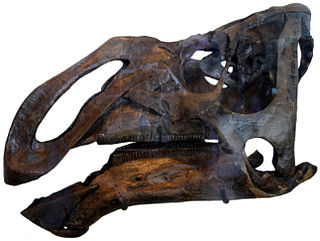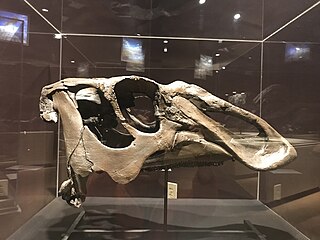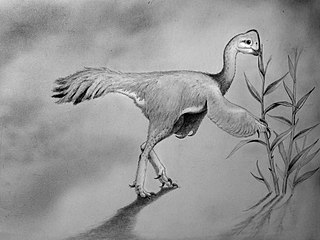
Hadrosaurus is a genus of hadrosaurid ornithopod dinosaurs that lived in North America during the Late Cretaceous Period in what is now the Woodbury Formation In Pennsylvania about 78-80 Ma. The holotype specimen was found in fluvial marine sedimentation, meaning that the corpse of the animal was transported by a river and washed out to sea.

Hadrosaurids, or duck-billed dinosaurs, are members of the ornithischian family Hadrosauridae. This group is known as the duck-billed dinosaurs for the flat duck-bill appearance of the bones in their snouts. The ornithopod family, which includes genera such as Edmontosaurus and Parasaurolophus, was a common group of herbivores during the Late Cretaceous Period. Hadrosaurids are descendants of the Late Jurassic/Early Cretaceous iguanodontian dinosaurs and had a similar body layout. Hadrosaurs were among the most dominant herbivores during the Late Cretaceous in Asia and North America, and during the close of the Cretaceous several lineages dispersed into Europe, Africa, and South America.

Brachylophosaurus was a mid-sized member of the hadrosaurid family of dinosaurs. It is known from several skeletons and bonebed material from the Judith River Formation of Montana, the Wahweap Formation of Utah and the Oldman Formation of Alberta, living about 81-76.7 million years ago.

Gryposaurus was a genus of duckbilled dinosaur that lived about 80 to 75 million years ago, in the Late Cretaceous of North America. Named species of Gryposaurus are known from the Dinosaur Park Formation in Alberta, Canada, and two formations in the United States: the Lower Two Medicine Formation in Montana and the Kaiparowits Formation of Utah. A possible additional species from the Javelina Formation in Texas may extend the temporal range of the genus to 66 million years ago.

Kritosaurus is an incompletely known genus of hadrosaurid (duck-billed) dinosaur. It lived about 74.5-66 million years ago, in the Late Cretaceous of North America. The name means "separated lizard", but is often mistranslated as "noble lizard" in reference to the presumed "Roman nose".

Tsintaosaurus is a genus of hadrosaurid dinosaur from China. It was about 8.3 metres (27 ft) long and weighed 2.5 tonnes. The type species is Tsintaosaurus spinorhinus, first described by Chinese paleontologist C. C. Young in 1958.

Anasazisaurus is a genus of saurolophine hadrosaurid ("duckbill") ornithopod dinosaur that lived about 74 million years ago, in the Late Cretaceous Period. It was found in the Farmington Member of the Kirtland Formation, in the San Juan Basin of New Mexico, United States. Only a partial skull has been found to date. It was first described as a specimen of Kritosaurus by Jack Horner, and has been intertwined with Kritosaurus since its description. It is known for its short nasal crest, which stuck out above and between its eyes for a short distance.

Secernosaurus is a genus of herbivorous dinosaur. Secernosaurus was a hadrosaur, a "duck-billed" dinosaur which lived during the Late Cretaceous.

Prosaurolophus is a genus of hadrosaurid dinosaur from the Late Cretaceous of North America. It is known from the remains of at least 25 individuals belonging to two species, including skulls and skeletons, but it remains obscure. Its fossils have been found in the late Campanian-age Upper Cretaceous Dinosaur Park Formation in Alberta, and the roughly contemporaneous Two Medicine Formation in Montana, dating to around 75.5-74.0 million years ago. Its most recognizable feature is a small solid crest formed by the nasal bones, sticking up in front of the eyes.

Naashoibitosaurus is a genus of hadrosaurid dinosaur that lived about 73 million years ago, in the Late Cretaceous, and was found in the Kirtland Formation of the San Juan Basin in New Mexico, United States. Only a partial skeleton has been found to date. It was first described as a specimen of Kritosaurus by Jack Horner, and has been intertwined with Kritosaurus since its description.

Koutalisaurus is a potentially dubious genus of extinct hadrosaurid dinosaur from the Arenysaurini. It is based on a mostly complete dentary from the Maastrichtian-age Upper Cretaceous Tremp Formation near the town of Abella de la Conca, Lleida, Spain.

The Aguja Formation is a geological formation in North America, exposed in Texas, United States and Chihuahua and Coahuila in Mexico, whose strata date back to the Late Cretaceous. Dinosaur remains are among the fossils that have been recovered from the formation. Fossil palms have also been unearthed here.

The Javelina Formation is a geological formation in Texas. Dating has shown that the strata date to the Maastrichtian stage of the Late Cretaceous, approximately 70 to 66.5 million years old. The middle part of the formation has been dated to about 69 million years ago plus or minus 1 million years and the top situated near the Cretaceous–Paleogene boundary, dated to 66 Ma ago. Dinosaur remains are among the fossils that have been recovered from the formation.
The El Picacho Formation is a geological formation in Texas, United States, whose strata date back to the Late Cretaceous. Dinosaur remains are among the fossils that have been recovered from the formation. The paleosols found here are rich in clay, calcite, and rhizoliths which show that during the Cretaceous period, this fossil formation, just like the neighboring Javelina Formation and Aguja Formation, was a fluvial flood plain.

Angulomastacator is a genus of duck-billed dinosaur from the Campanian-age Aguja Formation of Big Bend National Park, Texas. It is known from a single specimen, TMM 43681–1, a partial left maxilla. This bone is curved down approximately 45° at its anterior end, with the tooth row bent to fit, unlike any other hadrosaur. The unusual characteristics of the maxilla, which have not been reported from elsewhere, supports the hypothesis that the dinosaurs of the Aguja Formation were endemic forms. It was discovered in the upper shale member of the Aguja Formation, among plant, bone, and clam fragments in a bed interpreted as the deposits of a small tributary channel. This bed is just below rocks of the overlying Javelina Formation. Volcanic rocks at about the same level have been dated to 76.9 ± 1.2 million years ago.

Latirhinus is an extinct genus of lambeosaurine hadrosaurid dinosaur from the Late Cretaceous of Mexico. The type species, Latirhinus uitstlani, was named in 2012 on the basis of a partial skeleton from the Campanian-age Cerro del Pueblo Formation. The specific name uitstlani means "southern" in the Náhuatl language of Mexico, a reference to the species' southern occurrence in the Cretaceous landmass Laramidia.

This timeline of hadrosaur research is a chronological listing of events in the history of paleontology focused on the hadrosauroids, a group of herbivorous ornithopod dinosaurs popularly known as the duck-billed dinosaurs. Scientific research on hadrosaurs began in the 1850s, when Joseph Leidy described the genera Thespesius and Trachodon based on scrappy fossils discovered in the western United States. Just two years later he published a description of the much better-preserved remains of an animal from New Jersey that he named Hadrosaurus.

The Basturs Poble bonebed is a mega-bonebed of hadrosaur dinosaur fossils, discovered in Catalonia, Spain. Hundreds of hadrosaur fossils have been found at the site, which would have been on a large island during the Late Cretaceous when the animals preserved were alive. Despite the enormous amount of specimens, taxonomically informative material has been scarce at the site, leading to extensive debate as to its nature. The number of species present, age of the individuals present in the sample, and taxonomic identity of the remains have been the primary matters of debate. Previously considered to represent Koutalisaurus, Pararhabdodon, or multiple, perhaps dwarf species, it is currently thought that a single, indeterminate species of lambeosaurine was present at the site, and that individuals of many different ages were present.

Leptorhynchos is an extinct genus of caenagnathid theropod from the Late Cretaceous of what is now the US state of Texas, although it has been suggested to also exist in Alberta and South Dakota. The type species is L. gaddisi, and it is currently the only widely accepted valid species. The generic name of Leptorhynchos comes from the Greek "leptos" meaning "small" and "rhynchos" meaning "beak". The specific epithet is in honor of the Gaddis family, who owned the land on which the holotype was discovered.

Malefica is a genus of hadrosaurid dinosaur from the Late Cretaceous (Campanian) Aguja Formation of Texas. The type and only species is Malefica deckerti.




























